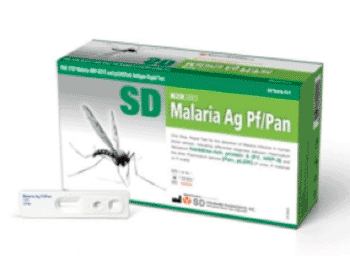Rapid Malaria Tests Accuracy Assessed for Hospitalized Child
By LabMedica International staff writers
Posted on 27 Jan 2014
Rapid diagnostic tests for malaria are now extensively used in Africa to fulfill the need of parasite-based diagnosis, which means the parasitological confirmation of malaria before the start of treatment. Posted on 27 Jan 2014
Most RDTs used detect Plasmodium falciparum histidine-rich protein-2 (PfHRP2), though P. falciparum-specific parasite lactate dehydrogenase (Pf-pLDH)-detecting RDTs may have advantages over PfHRP2-detecting RDTs.

Image: Rapid Diagnostic Test for Malaria (Photo courtesy of Standard Diagnostics).
Clinical scientist from the Institute of Tropical Medicine (Antwerp, Belgium) carried out one-year survey during 2012 and 2013 in a rural area in the center-west region of Burkina Faso to assess proportions and incidence rates of invasive bacterial infections and severe malaria. Thick blood films (TBF) were stained with Giemsa and assessed for the presence of malarial parasites according to standard procedures.
The malaria rapid diagnostic tests evaluated were the RDT SD Bioline Malaria Antigen P.f (HRP2/pLDH) further referred to as SD90 and the SD50 that detects the protein PfHRP2 (Standard Diagnostics; Hagal-Dong, Republic of Korea).The SD 90 assay is a three-band test consisting of a control line and two test lines targeting PfHRP2 and Pf-pLDH. Real-time polymerase chain reaction (PCR) was performed in case of discordant results between microscopy and RDT.
During the one-year study period, 696 children, aged one month to 14 years, were included in the investigation. In 376 (54.0%) children, samples were P. falciparum positive; five of them had a mixed infection with P. malariae or P. ovale. Median P. falciparum parasite density was 43,231.5/μL. Among the 318 P. falciparum negative samples, two had P. ovale infection and 13 had pure P. falciparum gametocytaemia.
No invalid results were observed for the SD90 RDT. Among the P. falciparum-positive samples, PfHRP2 was positive in all samples while Pf-pLDH missed only one, resulting in an overall sensitivity of 100 and 99.5% for PfHRP2 and Pf-pLDH, respectively. Among the P. falciparum-negative samples, there were 139 PfHRP2and 29 Pf-pLDH false-positive lines corresponding to specificities of 56.3% and 90.9% respectively. For both detection antigens, specificity was lowest for children one to five years and in the rainy season.
The authors concluded that among children presenting with severe febrile illness in a seasonal hyperendemic malaria-transmission area, they observed similar sensitivity but lower specificity of PfHRP2 compared to Pf-pLDH-detection. They suggest that future studies should assess the diagnostic accuracy and safety of an appropriate Pf-pLDH-detecting RDT in field settings and if satisfying, replacement of PfHRP2 by Pf-pLDH-detecting RDTs should be considered. The study was published on January 13, 2014, in the Malaria Journal.
Related Links:
Institute of Tropical Medicine
Standard Diagnostics













